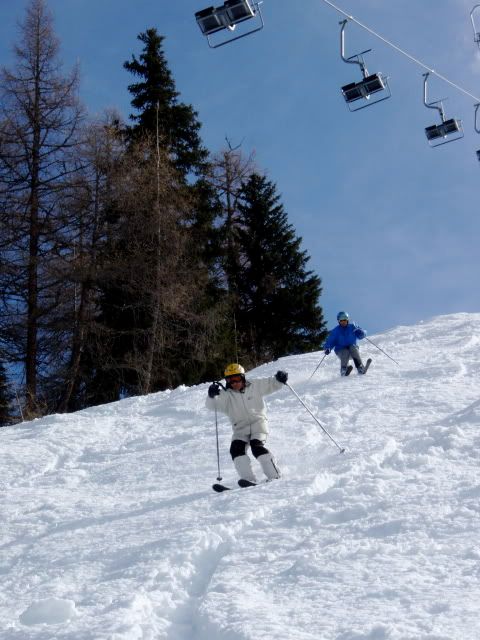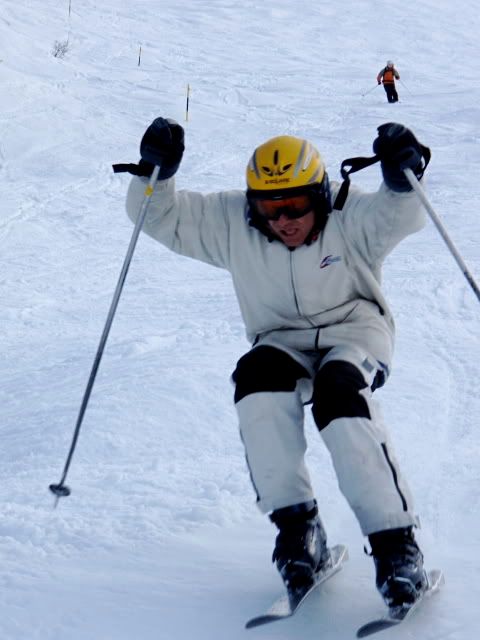I'm still trying to figure out TfA's code. Fucking guy's posts hurt my brain. For a lot of reasons.
Has anyone seen these in person? Maybe we're just being trolled. I feel like if you typed up a post in English, put it into a translator into German or probably any other language, and then back, you would get language like this. Never mind the content of the message. YEEESH.
Results 76 to 100 of 138
Thread: The new ski control / RaxSki
-
12-23-2013, 01:49 PM #76
-
12-23-2013, 03:08 PM #77
-
12-23-2013, 03:28 PM #78
There is another promising new market, Jumpturn: "fun piste". Growing like mushrooms in Austria this winter. It should be a new type of park,
with new attractions but without big air and hard equipment. Fun piste requires a maneuverable ski.
What do you think, Jumpturn ?
-
12-24-2013, 04:40 AM #79
-
12-25-2013, 03:53 AM #80
-
12-25-2013, 04:07 PM #81
-
12-26-2013, 11:35 PM #82
-
12-27-2013, 07:58 AM #83
-
12-27-2013, 01:48 PM #84
I`ve expected your negative reaction, Jumpturn! Yeah, you are more eco skier than me.
You are right, a fun piste is far from a free couloir. But it could be more natural than a highway-like groomer. And much safer than an avalanche couloir. So let`s be realistic

This one is a "Hotel couloir" on Schneeberg as viewed from the hotel terrace. All victims here were hotel guests.Last edited by Tom from Austria; 12-27-2013 at 03:22 PM.
-
12-27-2013, 02:05 PM #85
a couple of years ago we met with Tom and tried his invention. I can assure you that he is a real person and quite serious about these skis. He means what he is saying. He is a genuine and friendly guy and left a few pairs with us, would be happy to let you demo. I think there is even a powder model floating around somewhere. They ski like snowblades with fins, more or less like one might expect. I can't say I quite agree with Tom's assessment of the great merits of Rax skis, but he's a fun dude. I still hope to someday meet OBF.
tom and friend

tom

buddy with a less aggressive style

great for long lift rides

even one-foot talltee friend had fun.

Last edited by klar; 12-27-2013 at 02:21 PM.
Ich bitte dich nur, weck mich nicht.
-
12-27-2013, 03:16 PM #86
-
12-27-2013, 05:04 PM #87
-
12-27-2013, 06:12 PM #88
well, that was not really slush. Look at these firm fragments - it had to be quite hard snow. Rather a late spring snow just being converted to "Firn". Maybe the best snow of the year - no danger of avalanche.
Yes, these boots are very old but extremely light for a back pack. Half the weight of normal boots. Would be too hard for a 2m ski.

Last edited by Tom from Austria; 12-27-2013 at 06:23 PM.
-
12-27-2013, 08:21 PM #89
Thank you for the response. I ski more traditional, here in the US of A we call it XCD (Cross-country Downhill) but it resembles more of what was once traditional telemark skiing before heavy plastic boots and stiff springs and TGR. The Voile 3pin is the clamp rat-trap (binding) of choice on our xcd skis.
I'm the best DPP in the West.
-
12-27-2013, 09:54 PM #90
 Chowder Lover
Chowder Lover
- Join Date
- Mar 2010
- Location
- Co
- Posts
- 1,169
-
12-28-2013, 04:32 AM #91
You can admire this sweater in New Englands Ski Museum at Cannon Mt now. Other questions?
Ah ja, is RaxSki good for your knies? The answer from more than thousand customers worldwide and odd thousands testers
sounds: YES. The reason is that all control elements (=all parts of the ski producing substantial drag) are positioned BEHIND
your boots. Moreover every short ski spares you knees, makes turns very easy. RaxSki could be a recommended therapy for those hundreds thousands of women who have lost their crucial ligaments on modern shaped skis in the last 20 years.
"Holding the edge" means in case of RaxSki "Keeping the track with side-fins, wings and the front part of edge).
Yeah, just check your track and the Rax track under equal conditions! Rax is the last one to start skidding aside.
-
12-28-2013, 09:38 AM #92
-
12-28-2013, 10:32 AM #93
Yeah, the ski tradition, the glorious 30`s and 40`s ...
A famous ski historian (born in UK) said one day that if RaxSkis were available to at least some of ski-enthusiasts in 1930`s and 1950`s
as an alternative to regular long skis, then today`s regular skis (shaped carver and twin tips) would be just niche products for special purposes.
Well, our grand parents would hapilly vote for an easy turning short ski with the best tracking feature, especially in the era of not groomed pistes.
-
12-28-2013, 05:34 PM #94
It was a nice day you and your friends were testing Rax!
But we are also testing our testers, just to evaluate who could be a potential Rax rider.
Here are the results:
Skiers on piste
this ski lets you turn fast without skidding and love soft moguls and icy spots. You will ski them safely. Some of you will even leave the groomed piste and taste the virgin snow the first time. Old dreams can come true with RaxSki.
Freeriders off-piste
we have invented this ski for ourselves and we belong to you! No "jump turns" around each tree more needed. Just keep your balance and surf or carve effortless down the slope. This means higher performance by new technology.
Beginners at any age
you will find that this light ski will understand you. Just twist your knees and the ski starts turning. No angulating, weight transfer, nothing! Well, your knees and boots control the direction the same way as the steering wheel in your car.
But this ski also got the brake. Just lean back and rear fins start cutting the snow and braking. To your suprise you will not fall back but stop and keep upright.
Children and youngsters
for they are still free from established skiing conventions. They quickly discover the potential of the new ski and learn the unknown technique in no time. RaxSki gives them the opportunity to grow and to ski circles around shocked parents.
Snowboarders, especially the best ones
you would never step in a ski binding but the RaxSki is like the early-days snowboard: a revolt against the skiing establishment. Like a "rocker board" the RaxSki lets you rock on its bent base for easy turning.
Ski touring and backcountry lovers
We pity you, ski hikers suffering in deep and steep snow when you have to descend on your clumsy long skis. Change your material and habits and enjoy the slush!
Ski patrol and rescue service
RaxSki is the WORKHORSE among all skis. Wearing RaxSkis in extreme terrain lets you concentrate on rescue action. They will obey you and come through trees and bushes. They can even carve in grass. Light climbing boots for crampons can be used with RaxSki.
Snowblade, "firngleiter" and other short ski rider
you need no explanation about how to ride RaxSki! It will just track better and let you lean back without a fall.
Telemarkers and mono-skiers
I feel guilty that you are still waiting for our first TeleRax and MonoRax. Rocking on a monoski with huge rear fins could become the ultimate fun in powder.
Car drivers
RaxSkis fit in your luggage trunk. Model "Joker" is as short as a seat.
Wives and girl-friends of ski experts
RaxSki allows you to follow the track of your big teacher in the woods and watch him jumping on his conventional skis
while you are easy carving on Rax fins and wings.
Experts themselves
but that's not an easy mission! Because each of you has skied for tens of years and developed the best material ever. There is not much to be improved! Only the best of you will not feel ashamed to appear with an unknown "armored" ski that is shorter than 180cm.
-
12-28-2013, 07:59 PM #95
-
12-29-2013, 01:09 AM #96
Tom, unfortunately I don't have a connection to 0bernhardFranz. I have attempted to make contact but was not successfull, he seems a little eccentric. I think it is only a matter of time before the extreme figling community picks up on Rax. With the right kind of fin you could probably eliminate the need for snow entirely. I will suggest Rax to my wives and girlfriends, that is a very good idea!
Keep fighting the establishment.Ich bitte dich nur, weck mich nicht.
-
12-29-2013, 09:41 AM #97
 Chowder Lover
Chowder Lover
- Join Date
- Mar 2010
- Location
- Co
- Posts
- 1,169
Do you have any video other than POV of these things being skied?
-
12-29-2013, 03:09 PM #98
Thank you, Boss! Believe me, you will feel like a new born while riding down steep green slopes in hot summer. We have sold a pair to Denmark to ski sand dunes at the sea shore (!). This story is real, no joke!
"smoking grass" ? Not me, I am even denying the bottle before and during the skiing

-
12-29-2013, 03:28 PM #99
 trenchman
trenchman
- Join Date
- Feb 2010
- Posts
- 4,545
-
12-29-2013, 03:56 PM #100
Tom: I admire your commitment and resolve to spread the word about the RAX revolution. It may seem to you like you're a lone voice in the wilderness, but keep at it. I see the reactions here and think you're finally getting through to more and more maggots. And TGR is so powerful in the North American ski community because of our multiple sponsorships, industry connections and general stokeicity that once you really break through here on TGR, you'll find the sales will start rolling in and you will finally DOMINATE as you so deserve.
So keep on spending lots of time posting in this thread, replying to the naysayers and defending your turf. It'll be worth it!
With fondest regards,
BL2000Sometimes pride comes after a fall.




 Reply With Quote
Reply With Quote











Bookmarks